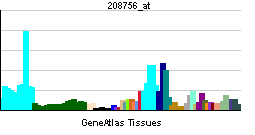EIF3I
| Eukaryotic translation initiation factor 3, subunit 2 beta, 36kDa | |||||||||||
|---|---|---|---|---|---|---|---|---|---|---|---|
| Identifiers | |||||||||||
| Symbols | EIF3S2 ; TRIP1; PRO2242; TRIP-1; eIF3-beta; eIF3-p36; eIF3i | ||||||||||
| External IDs | Template:OMIM5 Template:MGI HomoloGene: 2786 | ||||||||||
| |||||||||||
| RNA expression pattern | |||||||||||
 | |||||||||||
| More reference expression data | |||||||||||
| Orthologs | |||||||||||
| Template:GNF Ortholog box | |||||||||||
| Species | Human | Mouse | |||||||||
| Entrez | n/a | n/a | |||||||||
| Ensembl | n/a | n/a | |||||||||
| UniProt | n/a | n/a | |||||||||
| RefSeq (mRNA) | n/a | n/a | |||||||||
| RefSeq (protein) | n/a | n/a | |||||||||
| Location (UCSC) | n/a | n/a | |||||||||
| PubMed search | n/a | n/a | |||||||||
Eukaryotic translation initiation factor 3, subunit 2 beta, 36kDa, also known as EIF3S2, is a human gene.[1]
References
Further reading
- Chen RH, Miettinen PJ, Maruoka EM; et al. (1995). "A WD-domain protein that is associated with and phosphorylated by the type II TGF-beta receptor". Nature. 377 (6549): 548–52. doi:10.1038/377548a0. PMID 7566156.
- Akoulitchev S, Mäkelä TP, Weinberg RA, Reinberg D (1995). "Requirement for TFIIH kinase activity in transcription by RNA polymerase II". Nature. 377 (6549): 557–60. doi:10.1038/377557a0. PMID 7566158.
- Maruyama K, Sugano S (1994). "Oligo-capping: a simple method to replace the cap structure of eukaryotic mRNAs with oligoribonucleotides". Gene. 138 (1–2): 171–4. PMID 8125298.
- Asano K, Kinzy TG, Merrick WC, Hershey JW (1997). "Conservation and diversity of eukaryotic translation initiation factor eIF3". J. Biol. Chem. 272 (2): 1101–9. PMID 8995409.
- Méthot N, Rom E, Olsen H, Sonenberg N (1997). "The human homologue of the yeast Prt1 protein is an integral part of the eukaryotic initiation factor 3 complex and interacts with p170". J. Biol. Chem. 272 (2): 1110–6. PMID 8995410.
- Suzuki Y, Yoshitomo-Nakagawa K, Maruyama K; et al. (1997). "Construction and characterization of a full length-enriched and a 5'-end-enriched cDNA library". Gene. 200 (1–2): 149–56. PMID 9373149.
- Galli-Stauber C, Raho G, Rossi D; et al. (1998). "Genomic structure and chromosomal location of the human TGFbeta-receptor interacting protein-1 (TRIP-1) gene to 1p34.1". FEBS Lett. 426 (2): 279–82. PMID 9599024.
- Choy L, Derynck R (1998). "The type II transforming growth factor (TGF)-beta receptor-interacting protein TRIP-1 acts as a modulator of the TGF-beta response". J. Biol. Chem. 273 (47): 31455–62. PMID 9813058.
- Block KL, Vornlocher HP, Hershey JW (1998). "Characterization of cDNAs encoding the p44 and p35 subunits of human translation initiation factor eIF3". J. Biol. Chem. 273 (48): 31901–8. PMID 9822659.
- Poelzl G, Kasai Y, Mochizuki N; et al. (2000). "Specific association of estrogen receptor beta with the cell cycle spindle assembly checkpoint protein, MAD2". Proc. Natl. Acad. Sci. U.S.A. 97 (6): 2836–9. doi:10.1073/pnas.050580997. PMID 10706629.
- McGonigle S, Beall MJ, Pearce EJ (2002). "Eukaryotic initiation factor 2 alpha subunit associates with TGF beta receptors and 14-3-3 epsilon and acts as a modulator of the TGF beta response". Biochemistry. 41 (2): 579–87. PMID 11781097.
- Strausberg RL, Feingold EA, Grouse LH; et al. (2003). "Generation and initial analysis of more than 15,000 full-length human and mouse cDNA sequences". Proc. Natl. Acad. Sci. U.S.A. 99 (26): 16899–903. doi:10.1073/pnas.242603899. PMID 12477932.
- Mayeur GL, Fraser CS, Peiretti F; et al. (2003). "Characterization of eIF3k: a newly discovered subunit of mammalian translation initiation factor elF3". Eur. J. Biochem. 270 (20): 4133–9. PMID 14519125.
- Fraser CS, Lee JY, Mayeur GL; et al. (2004). "The j-subunit of human translation initiation factor eIF3 is required for the stable binding of eIF3 and its subcomplexes to 40 S ribosomal subunits in vitro". J. Biol. Chem. 279 (10): 8946–56. doi:10.1074/jbc.M312745200. PMID 14688252.
- Lehner B, Sanderson CM (2004). "A protein interaction framework for human mRNA degradation". Genome Res. 14 (7): 1315–23. doi:10.1101/gr.2122004. PMID 15231747.
- Gerhard DS, Wagner L, Feingold EA; et al. (2004). "The status, quality, and expansion of the NIH full-length cDNA project: the Mammalian Gene Collection (MGC)". Genome Res. 14 (10B): 2121–7. doi:10.1101/gr.2596504. PMID 15489334.
- Rush J, Moritz A, Lee KA; et al. (2005). "Immunoaffinity profiling of tyrosine phosphorylation in cancer cells". Nat. Biotechnol. 23 (1): 94–101. doi:10.1038/nbt1046. PMID 15592455.
- Rual JF, Venkatesan K, Hao T; et al. (2005). "Towards a proteome-scale map of the human protein-protein interaction network". Nature. 437 (7062): 1173–8. doi:10.1038/nature04209. PMID 16189514.
- Guo D, Han J, Adam BL; et al. (2005). "Proteomic analysis of SUMO4 substrates in HEK293 cells under serum starvation-induced stress". Biochem. Biophys. Res. Commun. 337 (4): 1308–18. doi:10.1016/j.bbrc.2005.09.191. PMID 16236267.
- Oh JH, Yang JO, Hahn Y; et al. (2006). "Transcriptome analysis of human gastric cancer". Mamm. Genome. 16 (12): 942–54. doi:10.1007/s00335-005-0075-2. PMID 16341674.
| This protein-related article is a stub. You can help Wikipedia by expanding it. |